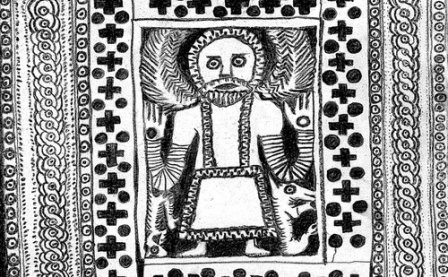Áine O’Dwyer’s last album for MIE was recorded in a church. Given the rare opportunity to make recordings using the pipe organ in St. Mark’s Church in Islington, London, the sound artist visited the instrument over the course of several months, applying the same pensive, drifting method that she had come to employ in her harp music to a much grander set of tools. The resulting album, Music for Church Cleaners, is tempered by the curious effect of the various other people present in the church at the time of the recording, whether it be the janitorial staff, children playing, or a woman approaching O’Dwyer requesting that she refrain from the extended drones and to please add more notes to her music. These various elements coalesced together to create a work as transcendent as it was ordinary, a humanizing version of holy music that somehow made the sound of a vacuum cleaner seem strangely consequential.
For her latest album, Áine O’Dwyer recorded in a cave. A tunnel, to be more precise; taking up residency in the Brunel tunnel shaft beneath the River Thames, O’Dwyer sought to not only document the unique feeling of the space, but also practice the ancient art of keening — to wail in grief. During the construction of the Brunel tunnel in the early 19th century, six men drowned as the result of an unexpected flood, and that eerie sense of history courses through the music’s deep, disembodied aura. O’Dwyer channels the vocal style of the bean chointe, old Irish mourners thought of as banshees who would wander the land moaning for their departed ones, cast out by society, in a sense becoming ghosts themselves. Combined with her amorphous harp playing, tumbling percussion, and cavernous field recordings, Gallarais is a slippery and engulfing album, lined with sonic details that seem both harrowing and happenstance in equal measure.
Oftentimes, Gallarais is resistant to shape, with collages like “Grottovox” and “Beansidhe” balancing the reveberations of airplanes gliding above with earthy drum sounds and even echoes that seem to emerge from within the depths of the tunnel. These sections are balanced out by tracks like “Underlight” and “Mouthtoum” that demonstrate O’Dwyer’s effortlessly sorrowful approach to flute and harp, providing a musical grounding that still feels as improvised and as accidental as any of the less-controlled tones. But it’s really O’Dwyers voice that brings the scattered phantoms of Gallarais together, with the slowly accumulating non-harmonies of pieces like “Hounds of Hades” evoking the kind of wilted, helpless folk music sung long ago by those keeners sentenced to a solitude of agony. In channeling their spirits, O’Dwyer has yet again summoned the divine by delving beneath the veneer of the mundane, revealing how even something as routine as a public transportation line might house some of our most painful, otherworldly secrets.
More about: Áine O'Dwyer




